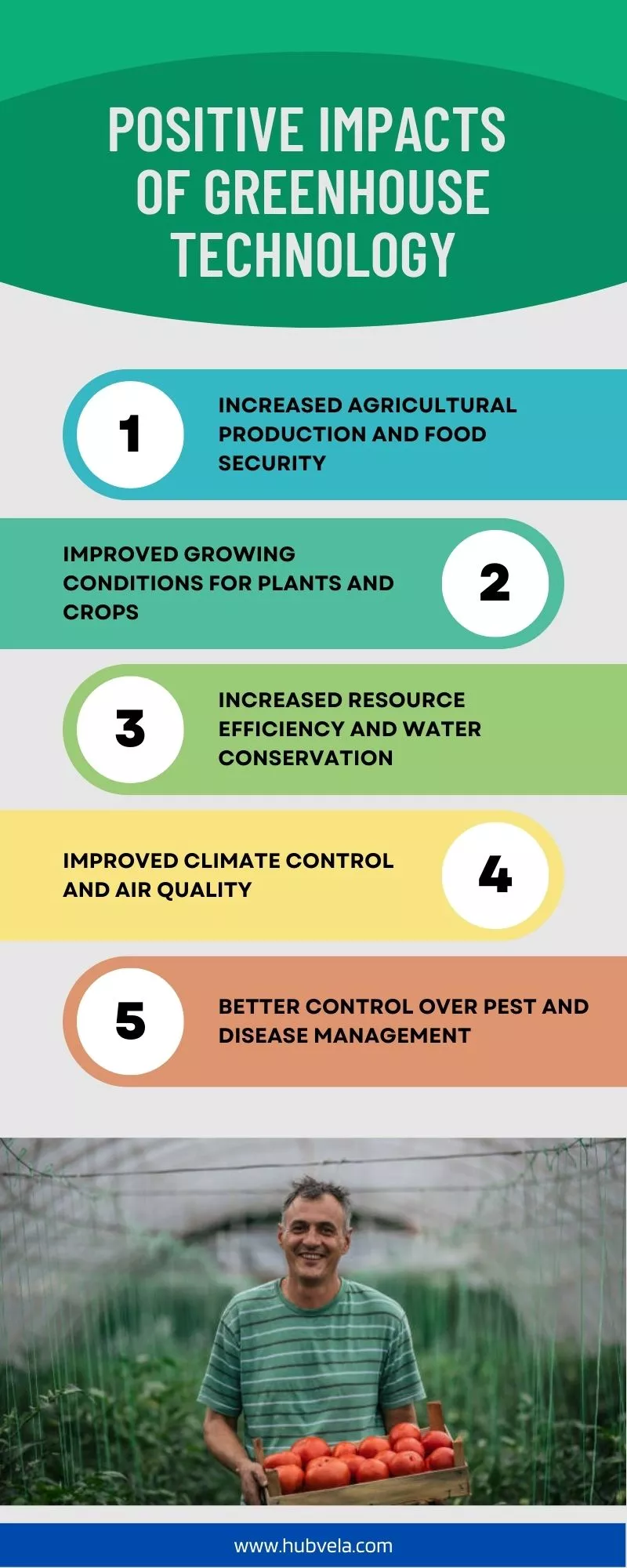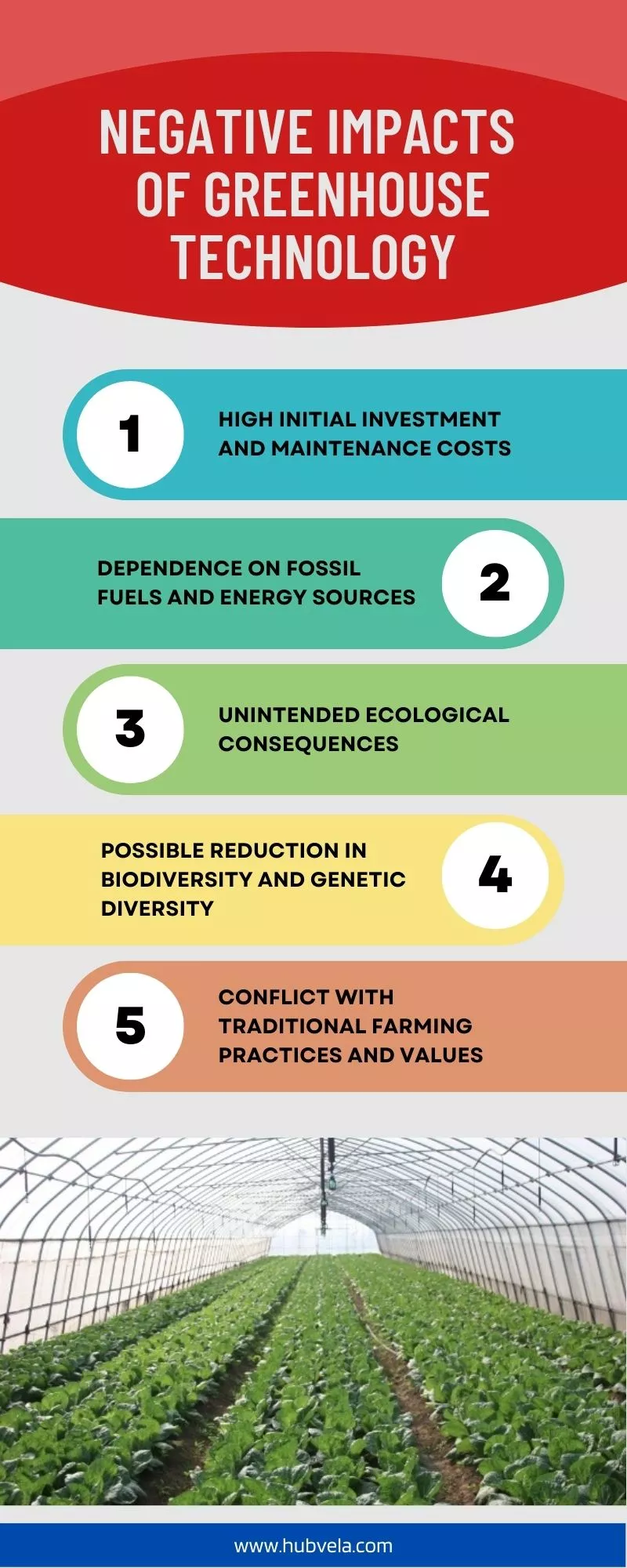Greenhouse technology has been a game-changer in the agricultural industry, allowing for year-round crop production and increased yields.
However, like any technology, it has both positive and negative impacts on the environment and society.
In this article, we will explore the positive and negative impacts of greenhouse technology and its role in sustainable agriculture.

--Advertisement--
Positive Impacts of Greenhouse Technology
Greenhouse technology has revolutionized the way we grow crops and plants, and its positive impacts on the environment cannot be overstated. As a natural phenomenon, the greenhouse effect is beneficial for us.
By trapping heat close to the Earth’s surface, greenhouse gases like carbon dioxide, methane, and water vapor help maintain the planet’s temperature at a level suitable for the development of life.
In this context, greenhouse technology has allowed us to create an artificial environment that mimics the natural greenhouse effect, providing a paradise for plants to grow and thrive.
We will explore some of the major positive impacts of greenhouse technology.

1. Increased Agricultural Production and Food Security
Greenhouse technology has had a positive impact on agricultural production and food security.
With the world’s population projected to increase by 2 billion by 2050, there is a need for increased productivity and sustainability in agriculture.
Greenhouse technology has enabled farmers to grow crops in controlled environments, leading to increased yields and reduced water usage.
This technology has also allowed for year-round production, reducing the risk of crop failure due to weather conditions.
With the threat of climate change and air pollution, greenhouse technology provides a solution to mitigate the negative impacts on crops and forests.
By increasing agricultural production, greenhouse technology can contribute to food security, ensuring that there is enough food to feed the growing population.
2. Improved Growing Conditions for Plants and Crops
By providing controlled environments, we can optimize growing conditions and increase yields.
This technology has a positive impact on agriculture by allowing crops to be grown anywhere, regardless of weather conditions, availability of cultivable land, or soil quality.
With improved growing conditions, plants can experience reduced photosynthesis, faster growth, and higher resistance to diseases.
Mixing trees and crops can help both farmers and the climate by reducing deforestation and increasing carbon sequestration.
Overall, greenhouse technology has the potential to transform agriculture and improve food security for generations to come.
3. Increased Resource Efficiency and Water Conservation
By using advanced technology, greenhouse farmers can optimize their use of resources such as water, soil, and energy, resulting in more efficient and sustainable production.
This not only benefits the environment but also helps to reduce costs for farmers.
Greenhouse technology allows for precise control of water usage, which can help to conserve this precious resource.
By using water more efficiently, greenhouse farmers can help to mitigate the effects of drought and protect drinking water resources.
Overall, greenhouse technology is a powerful tool for promoting resource efficiency and water conservation, and its benefits will only continue to grow in the years to come.
4. Improved Climate Control and Air Quality
Greenhouse technology has brought about numerous positive impacts on our environment, including improved climate control and air quality.
With the use of advanced greenhouse systems, it is now possible to regulate temperature, humidity, and air circulation, creating an optimal environment for plant growth while reducing the risk of pests and diseases.
Moreover, greenhouse technology has also led to a significant reduction in the use of harmful pesticides and fertilizers, which can have a detrimental impact on air quality.
By using natural pest control methods and organic fertilizers, greenhouse growers can produce healthier crops while minimizing their environmental impact.
Overall, the positive impacts of greenhouse technology on climate control and air quality cannot be overstated.
As we continue to face the challenges of climate change and environmental degradation, it is clear that greenhouse technology will play a critical role in creating a more sustainable and resilient future for us all.
5. Better Control over Pest and Disease Management
Greenhouse technology has brought about better control over pest and disease management, resulting in increased crop yields and reduced losses due to plant pests and diseases.
With the use of greenhouse disease and insect management recommendations, such as the “A” and “B” team products, greenhouse growers can provide the best disease control and limited control, respectively, to their crops.
Additionally, biocontrol of insects in greenhouses and nurseries is an effective pest management strategy that is increasing in use and application.
As a result, greenhouse technology has contributed positively to the reduction of global economic losses due to plant diseases and invasive insects, which cost more than $220 billion and $70 billion, respectively, each year.
6. Increased Farmer Income and Economic Growth
The use of greenhouse technology has had a positive impact on the income of farmers and overall economic growth.
According to the World Bank, growth in the agriculture sector is two to four times more effective in raising incomes among the poorest compared to other sectors.
With the use of greenhouse technology, farmers can increase their crop yields and produce crops all year round, leading to increased income.
This increased income not only benefits the farmers but also the local economy as a whole.
As stated by AgAmerica, net farm income is forecasted to decline in 2022, but it is still 26 percent higher than the 10-year average.
The use of greenhouse technology can help to mitigate this decline and ensure that farmers continue to earn a sustainable income.
Negative Impacts of Greenhouse Technology
Greenhouse technology has been widely used in agriculture to increase crop yields and protect plants from harsh weather conditions.
However, this technology also has negative impacts on the environment and human health.
The greenhouse effect, caused by the presence of greenhouse gases such as carbon dioxide and methane, leads to a warming of the Earth’s surface and troposphere.
The use of greenhouses can lead to a lack of wind for pollination, which can negatively impact crop production.
It is important to consider these negative impacts of greenhouse technology and find ways to mitigate them while still utilizing the benefits of greenhouse technology.

1. High Initial Investment and Maintenance Costs
Greenhouse technology has the potential to revolutionize agriculture, but it comes with high initial investment and maintenance costs.
The cost of building and maintaining a greenhouse can be a significant barrier for farmers, especially those in developing countries.
The cost of capital in clean energy transitions and the cost-benefit analysis for business cases are important factors to consider when investing in greenhouse technology.
The advantages and disadvantages of using industrial robots in manufacturing can be applied to greenhouse technology, as automation can reduce direct labor costs but also require maintenance.
To reduce maintenance costs, proper planning and management are crucial. While greenhouse technology has many benefits, it is important to consider the financial implications and ensure that it is a sustainable investment for farmers.
2. Dependence on Fossil Fuels and Energy Sources
The negative impacts of greenhouse technology are closely linked to our dependence on fossil fuels and non-renewable energy sources.
As long as we continue to rely on these finite resources, we will continue to emit harmful greenhouse gases into the atmosphere, exacerbating the effects of climate change.
While there are challenges to transitioning to renewable energy sources, such as the need for infrastructure and investment, we must make this shift as soon as possible.
We need to prioritize the development and implementation of sustainable energy systems to mitigate the negative impacts of greenhouse technology and ensure a livable future for generations to come.
3. Unintended Ecological Consequences
Greenhouse technology has been widely adopted to mitigate the effects of climate change, but it also has unintended ecological consequences.
The use of chemical fertilizers and pesticides in greenhouse farming can lead to soil and water pollution, negatively impacting the health of plants and animals living within the ecosystem.
Additionally, the energy-intensive nature of greenhouse technology can contribute to greenhouse gas emissions, exacerbating the very problem it seeks to solve.
It is important to consider the potential negative impacts of greenhouse technology and work towards sustainable solutions that minimize harm to the environment.
4. Possible Reduction in Biodiversity and Genetic Diversity
The use of greenhouse technology has been linked to a possible reduction in biodiversity and genetic diversity.
This is because the use of such technology can lead to habitat loss, deforestation, and pollution, which are key drivers of biodiversity loss.
Biodiversity loss can have significant negative impacts on the planet, including the collapse of entire ecosystems and the reduction in ecosystem services that underpin the global economy.
As such, it is important to consider the potential negative impacts of greenhouse technology on biodiversity and take steps to mitigate these impacts.
5. Conflict with Traditional Farming Practices and Values
The implementation of greenhouse technology in agriculture has brought about negative impacts that conflict with traditional farming practices and values.
While traditional farming has been ever-evolving, the use of greenhouse technology has led to the displacement of natural ecosystems and habitats, leading to deforestation and ecological destruction.
The use of such technology has led to a shift in farming practices, which conflicts with the values of regenerative agriculture, where farmers prioritize healthy soils, ecosystems, communities, and climate.
As such, it is important to consider the negative impacts of greenhouse technology and find ways to mitigate them while still ensuring sustainable agricultural practices.
Conclusion on the Positive and Negative Impacts of Greenhouse Technology
In conclusion, greenhouse technology has both positive and negative impacts on our planet.
On the positive side, it allows us to grow crops in areas where they would not normally thrive, and it can help to reduce our reliance on fossil fuels by providing alternative sources of energy.
However, the negative impacts of greenhouse gases on our climate cannot be ignored. The increase in concentrations of these gases in the atmosphere is causing climate change, which is leading to more extreme weather events and changes in precipitation patterns.
We must continue to research and develop new technologies that can help to mitigate the negative impacts of greenhouse gases, while still allowing us to benefit from the positive aspects of greenhouse technology.
By working together, we can create a more sustainable future for ourselves and for generations to come.


